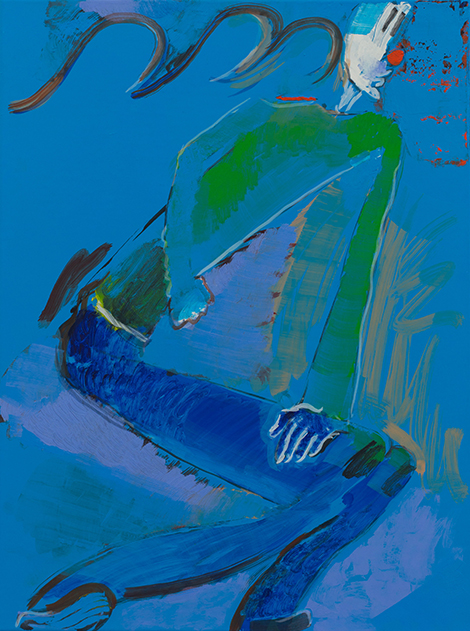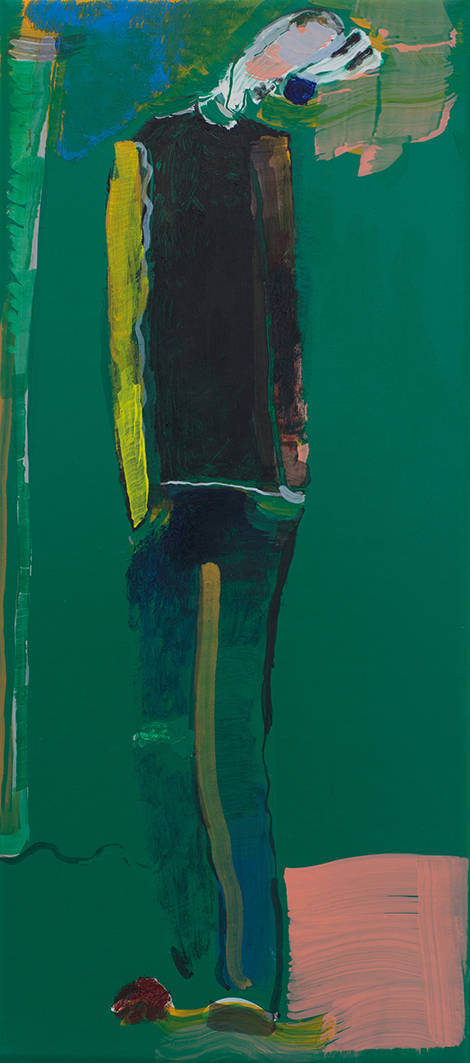A recognizable figure or persona, which may or may not stand in for the artist but, regardless, bears on his relationship to the world and his painterly address of it, emerges in the Berlin-based painter Ulrich Wulff’s most recent show, “Preparations.” Call it the shrugging or slouching man, it retains the cartoonish hyperthalmic eye-stalks Wulff has used previously, but Wulff invokes a tentative, vanishing point quality, as if the figure might disappear or be rendered invisible behind the field of inquiry. In Inside or Outside the Cave (all works 2015), the figure’s head disappears at the top of a black keyhole, which itself is cut out of a matte blue that envelops the canvas and is also the color of the figure. In Short Story, two figures face each other, one whose legs and back elide off beyond the left edge of the canvas, and the other whose upper half may not even properly exist—it resides within an elusive space, a depicted window, a transparency that is fugitive.
Wulff’s painting evinces both a love of color and gestural abstraction, but it is a minimalist’s love. The gestures are contained, the textures restrained, the brush strokes deliberated. Incident is expressive precisely because it is so sparely pronounced. A line, brushstroke (frequently one and the same) or patch of color takes on an intensity and definition that render further articulation moot.
The recurring shift in Wulff’s work between abstraction and the shuffling figure bears some affinity with the kind of new image painting that enjoyed a vogue in the late 1970s and 1980s, but whose legacy has extended into this century. In other words, the ideogrammatic aspect of some of his previous work, though still present, has morphed into a pictogrammatic domain. The blur is evident in paintings like Arriving On Shores, as well as the aforementioned works. In Arriving, sequential hook-curves stand in for waves impelling the crouching figure, who may be a surfer, but whose posture also looks vaguely like a skier’s, forward. The qualities are only underscored by a perfectly articulated hand that rests on the skier-surfer’s knee.
Wulff nevertheless imposes an austere grammar on this more distinctly pictogrammatic work. Slouching man’s inquiry takes place against an existential void. The surfaces of the paintings are almost uniformly matte and opaque with background color tamped down and slightly chalky. The color or brushstroke itself takes on an ideogrammatic quality. However freely, loosely, even roughly applied, the mark is rarely casual. If there is room for accident, it seems almost pre-selected.
The epigrammatic quality of earlier work here builds cumulatively to a quasi-narrative. Given the titles, it’s hard not to view the paintings as a progression from the falling domino men of Between Memories to We’ll See, which depict the artist at his easel with pinks, violets and fuchsia looping vibrantly on a greenish canvas, and the appropriately titled Last Picture Shown, which, with its rows of slightly Mitchell-esque slashes, looks absolutely nothing like it. As the artist himself suggests, it’s all preparation.



